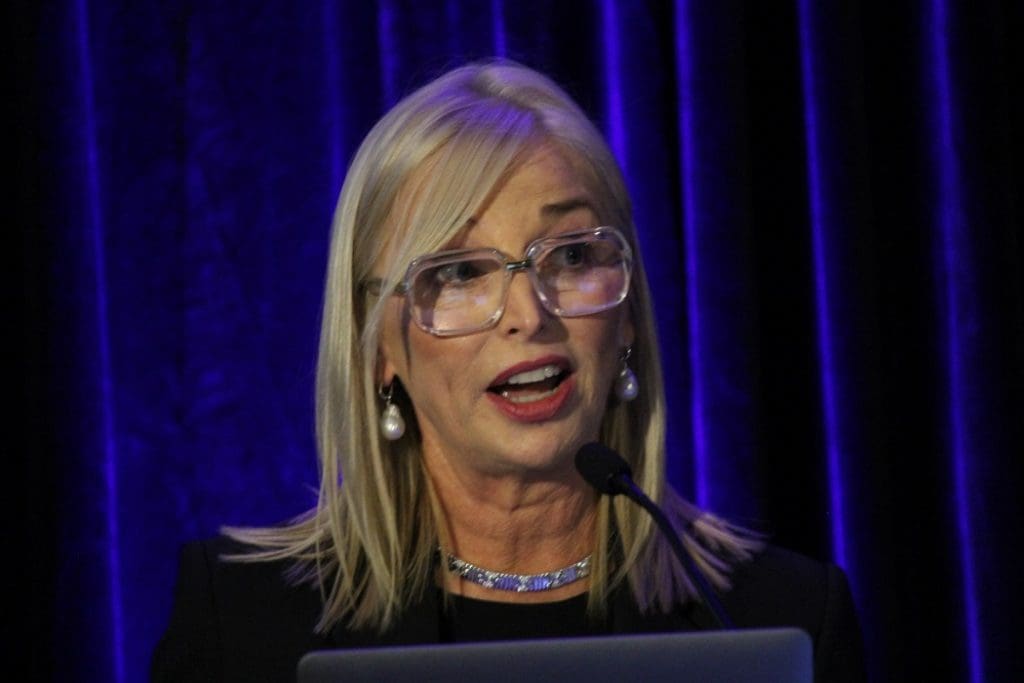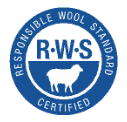
AWI chair Colette Garnsey at the research, development and marketing company’s 2019 annual general meeting.
AUSTRALIAN wool exporters and a leading global sheep welfare standard have rejected statements that non-mulesed wool demand was driven by a few European fashion houses and not garment customers.
Australian Wool Innovation chair Colette Garnsey last month told New South Wales sheep breeders that only a few European fashion houses were pushing non-mulesing.
“The non-mulesing push is coming from the Europeans and driven by two (fashion) houses who are really trying to avoid having to deal with animal activists who are camping on their doorsteps,” Ms Garnsey said at a 21st Central Western zone Merino ewe competition field day at Alectown.
In a Farmonline article, Ms Garnsey claimed that AWI is not a political body, although she effectively admitted that AWI continued to defend mulesing when talking to fashion houses, but also declared that AWI would not “come and declare for one side” on the mulesing debate.
“We are here to support all wool growers and that’s very much of what AWI is doing.”
Ms Garnsey said “it is actually strictly prohibited in the constitution for us to get into any type of politics.”
“What we can do is continue to do research and continue to advocate into those markets and along the supply chain for best practice animal husbandry, and that is the work we are doing.
“What does work is when we explain the story, which we do annually to all those houses, that mulesing is once in an animal’s life,” Ms Garnsey said.
“Just once; it doesn’t happen every year,” she said in the Farmonline story.
“It also enables wool production in Australia to continue to produce wool of the quality that is required by the world’s garment manufacturers.”
Ms Garnsey also said mulesing with anaesthetic pre, and analgesics post, are rated favourably with European and Chinese wool industry fashion houses and processors.
At the same event, World Federation of Merino Breeders president, Will Roberts, from Morven in Queensland, was quoted as saying that the “the only people who talk loudly about mulesing are those who don’t want to mules.”
“Those who do not want to mules, don’t mules if that’s what you want to do.
“But just shut up about it because it’s a road to nowhere and I don’t believe that it’s customers who are actually driving this.”
Non-mulesed wool demand is more extensive

Australian Council of Wool Exporters & Processors president Matt Hand
However, Australian Council of Wool Exporters and Processors Matt Hand said demand for non-mulesed wool is far more extensive than just a small number of European brands and it is consumer-driven.
“It’s hard to forget the statement late last year from Target & Kmart announcing they would move to only non-mulesed wool.
“Country Road is on the same path,” he said.
“Significant US owned outdoor/activewear brands such as Icebreaker, Smartwool only purchase non-mulesed wool.
“The bottom line is that a long list of global brands are acknowledging their consumers have an appetite to move away from mulesing,” Mr Hand said.
“This topic persists relentlessly, taking us away from so many other great discussions to have with consumers around wool as a natural, sustainable fibre and its vast superiority to fibres that have negative environmental impacts.
“How many consumers will reject wool from mulesed sheep, but are somehow comfortable to purchase polyester or acrylic?” he asked.
“I suspect far too many, it’s irrational, but a reality our industry faces.”
On Ms Garnsey’s statement that AWI is not a political body, Mr Hand said: “It’s a fine line between marketing and becoming political.”
“Endless energy has been contributed towards convincing anti mulesing brands, retailers and consumers to somehow relinquish and accept what they’ve been vocally rejecting for over a decade.
“An approach weighted more towards the contrary, with a positive focus on progression away from the practice of mulesing may lead to an equally positive reception,” he said.
“It seems a little illogical for the entire supply chain to source and ultimately pay unarguable premiums for non-mulesed wool if the customers were not demanding it.
“There’s no doubt it’s driven by consumers, the entire demand side of any retail equation is.”
Mr Hand said he recognised that he and Ms Garnsey wanted the Australian wool industry flourish and for growers to be rewarded.
“The issues are really around whether we equally value the capacity of global consumers to move a market and how strongly motivated are they to move completely towards products sourced from non-mulesed sheep.
“Delivering a healthy animal, with sufficient pain management should be rationally acceptable,” he said.
“Unfortunately negative and misleading messages have built a story around mulesing for well over a decade and it’s gained more momentum than our very rational arguments.
“Arguing with a consumer who knows what they want and believe they are buying responsibly is just not an argument you can expect to win, they just shop somewhere else and buy a product they feel ethically happy with,” Mr Hand said.
“We often hear that “it all sells”, it does and it will.
“It just doesn’t feel great to see Australian Wool begin to lose market share to others who now appear to be recognised as non-mulesing countries,” he said.
“They have significant advantages and they simply don’t share our challenges, that doesn’t change or even influence consumers’ minds.”
More companies see non-mulesed as the norm – Textile Exchange
 The Textile Exchange’s Responsible Wool Standard has become a global benchmark for verifying sheep welfare practices related to wool production, spurring the creation of other integrity schemes, and working with companies around the world, covering the fashion sector, outdoor, home and other aspects of textiles.
The Textile Exchange’s Responsible Wool Standard has become a global benchmark for verifying sheep welfare practices related to wool production, spurring the creation of other integrity schemes, and working with companies around the world, covering the fashion sector, outdoor, home and other aspects of textiles.
TE director of marketing communications and public relations, Donna Worley, said demand and inquiries for non-mulesed wool is coming from all sectors and all regions the exchange worked with.
“From our work with the industry, we are increasingly seeing companies with a non-mulesed wool policy as a norm.
“We are also seeing an increase of brands using standards such as the RWS to back up their policies.”
Ms Garnsey said Textile Exchange believed that mulesing is an animal welfare issue.
“There are other options for growers, and we encourage proactive adoption of practices that prevent the need for mulesing.”
She said there is strong consumer concern for animal welfare across the apparel sector and beyond.
“Brands and retailers are aware of the risks associated with mulesing and in some situations it is the brands and retailers that are driving the move rather than consumers.
“The ultimate driver behind demand for non-mulesed is concern for animal welfare, both by brands and consumers.”
Ms Worley said the exchange’s engagement with brands and retailers has confirmed that the use of pain relief is a positive step forward, but the ultimate goal should be ceased mulesing. She said Textile Exchange would be supportive of any steps to require mandatory pain relief.
“Due to the demand from brands and consumers, it is also in the commercial interest of the Australian wool industry to consider animal welfare.”
Australian Wool Network managing director John Colley said the company deals directly with many global fashion labels that are now using non-mulesed wool and as the exclusive supplier of Australian non-mulesed wool to New Zealand Merino, AWN was supplying to more than 80 different retailers, brands and labels which are requesting non-mulesed wool.
“And it’s growing every day.”
Garnsey refused to name non-mulesed fashion houses and brands
Ms Garnsey refused to personally respond to Sheep Central’s questions, which asked her to name the European fashion houses she referred to in her comments or any others she knew that were using non-mulesed wool.
Ms Garnsey would not name any non-European fashion house, wool processor or brand(s) already committed to, or moving toward, exclusive non-mulesed wool use. This is despite AWI’s marketing arm, The Woolmark Company, collaborating with several global fashion brands and retailers for decades, including Australian clothing retailer Country Road. CR chief executive officer Scott Fyfe told the 2019 Melbourne Wool Week forum it had committed to using only fleece from flocks verified as not mulesing or as having ceased mulesing in its pure wool products sold in stores by winter 2021. By winter 2023 all wool-rich products sold in CR stores will only use verified NM or CM-declared wool.
Instead, an AWI spokesman told Sheep Central said AWI regularly speaks with fashion houses and wool processors in Europe and China about their requirements.
“They report considerable demand for Australian wool irrespective of its status in terms of the National Wool Declaration.”
Ms Garnsey also refused to give definitions to the ‘anaesthetic pre’ and ‘analgesics post’ pain relief treatments she mentioned.
The AWI spokesman said AWI contributed to the review by the Australian Wool Exchange for the draft National Wool Declaration, which does not differentiate between pre and post AA (analgesia and anaesthesia).
“AWI accepts this.
“AWI strongly believes it is up to growers to decide what approach to take,” the spokesman said.
“At the same time AWI does not have a preference for the use of one product over any other.
“The latest edition of Beyond the Bale has a detailed article on this issue.”
Click here to read the full Farmonline article which has been verified as accurate by AWI’s media relations manager.

With the fly prevention chemicals becoming less effective and providing fly protection for a shorter time, the Merino industry will have to ask some questions of itself.
Body strike is a big issue and relies on chemicals for prevention in traditional flocks and practices. With chemical efficiency issues, where does the industry go from here?
I see a number of pathways: opting out of sheep, shedding wool types (Dorpers etc), continuing with the same sheep with continual fly control efforts or changing to a plain-bodied, fly-resistant type of Merino.
The last option means changing the type of Merino and fortunately this genotype is available and can be implemented in two sheep generations.
In doing so, mulesing is eliminated; no need for chemicals and you have a productive Merino.
A lot of commonsense expressed by Matt Hand in this article, but some unbelievable quotes by World Federation of Merino Breeders president, Will Roberts. Telling members of the industry who are genuinely concerned about the mulesing issue to “just shut up about it” is an incredibly divisive and negative attitude from someone in such a position. I’m sure that most of those who are expressing anti-mulesing views are, like myself, simply concerned about the financial implications of Australia continuing as the last remaining major wool exporter in the world to allow mulesing. Surely we have the right to express these views.
It is obvious that Will Roberts missed out on Marketing 101 — give the market the product they want and give it better than your opposition.
For a person in the position he holds, to say “just shut up about it” astounds me.
The drift in this discussion about mulesing is astonishing; as if we have learnt nothing from it over recent decades.
Organisations that are supposed to represent the broad interests of the wool industry have yet again lost the plot.
The two key objectives in this policy area, and it is not politics, are to protect sheep from fly strike in grazing areas where that is prone, and to do so in a manner that avoids cutting and pain; however ameliorated with pain killers.
There is no mention that I could see in the above report of the one technique now available that avoids cutting and pain and protects sheep against fly strike – and that is freeze branding with liquid nitrogen. I’ve tried to understand the reasoning of those who choose to continue bluffing their way over mulesing and are not prepared to acknowledge that freeze branding is not mulesing by any definition of mulesing.
They are not prepared to argue the case in the market place and have abandoned whatever influence that may be left to them in that regard.
I have witnessed freeze branding and have detected no pain in the animal and have watched whole flocks trotting their way back to paddocks after treatment without any sign of discomfort.
Andrew, I am sorry. When the freeze brand apparatus clamps onto the skin it kills all the nerves in that area. I believe the process of killing all those nerves is very painful. I am of the opinion that it is more painful than mulesing. The other thing to take into consideration when mulesing a lamb is that one can take more or less off with shears, depending on the amount of wrinkle. This is important, as a wool grower transitions to a plainer breech, they can adjust the mules. To the point of mulesing less and less lambs. I believe this is not possible with the freeze mulesing. The plainer breeches can have too much removed, and the wrinkly breeches, not enough; which will take us back to flyblown rear ends. I believe nitrogen leakage is also a problem and the volumes needed.
With respect, Mr Gordon, everyone has opinions.